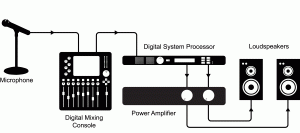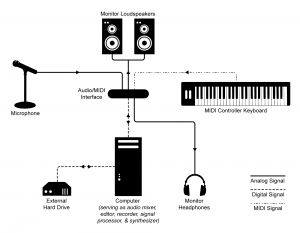Today’s world of sound processing is quite different from what it was just a few decades ago. A large portion of sound processing is now done by digital devices and software – mixers, dynamics processors, equalizers, and a whole host of tools that previously existed only as analog hardware. This is not to say, however, that in all stages – from capturing to playing – sound is now treated digitally. As it is captured, processed, and played back, an audio signal can be transformed numerous times from analog-to-digital or digital-to-analog. A typical scenario for live sound reinforcement is pictured in Figure 5.1. In this setup, a microphone – an analog device – detects continuously changing air pressure, records this as analog voltage, and sends the information down a wire to a digital mixing console. Although the mixing console is a digital device, the first circuit within the console that the audio signal encounters is an analog preamplifier. The preamplifier amplifies the voltage of the audio signal from the microphone before passing it on to an analog-to-digital converter (ADC). The ADC performs a process called digitization and then passes the signal into one of many digital audio streams in the mixing console. The mixing console applies signal-specific processing such as equalization and reverberation, and then it mixes and routes the signal together with other incoming signals to an output connector. Usually this output is analog, so the signal passes through a digital-to-analog converter (DAC) before being sent out. That signal might then be sent to a digital system processor responsible for applying frequency, delay, and dynamics processing for the entire sound system and distributing that signal to several outputs. The signal is similarly converted to digital on the way into this processor via an ADC, and then back through a DAC to analog on the way out. The analog signals are then sent to analog power amplifiers before they are sent to a loudspeaker, which converts the audio signal back into a sound wave in the air.

A sound system like the one pictured can be a mix of analog and digital devices, and it is not always safe to assume a particular piece of gear can, will, or should be one type or the other. Even some power amplifiers nowadays have a digital signal stage that may require conversion from an analog input signal. Of course, with the prevalence of digital equipment and computerized systems, it is likely that an audio signal will exist digitally at some point in its lifetime. In systems using multiple digital devices, there are also ways of interfacing two pieces of equipment using digital signal connections that can maintain the audio in its digital form and eliminate unnecessary analog-to-digital and digital-to-analog conversions. Specific types of digital signal connections and related issues in connecting digital devices are discussed later in this chapter.
The previous figure shows a live sound system setup. A typical setup of a computer-based audio recording and editing system is pictured in Figure 5.2. While this workstation is essentially digital, the DAW, like the live sound system, includes analog components such as microphones and loudspeakers.

Understanding the digitization process paves the way for understanding the many ways that digitized sound can be manipulated. Let’s look at this more closely.